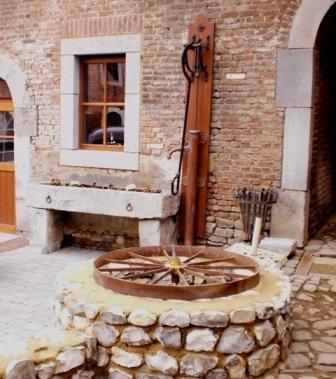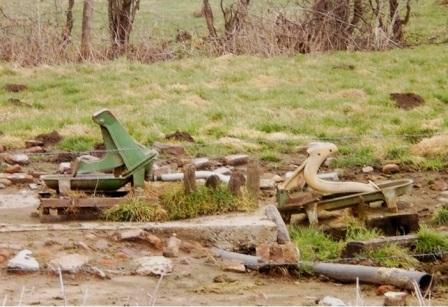Groundwater can be found at different depths. Clay layers can separate different aquifers. Often a deeper pit delivers better, less polluted water.
First you dig a pit in which you start drilling. Ensure that the upwelling water from the well can flow (or be pumped, scooped) away.
 The rig consists of screwed- together tubes (such as the galvanized water pipes commonly used). Whenever you go deeper, you screw an additional length on top. If you make turns it will be always clockwise, so that pipes fix firmer, but never can be loosened (even not while retiring the pipes up).
The rig consists of screwed- together tubes (such as the galvanized water pipes commonly used). Whenever you go deeper, you screw an additional length on top. If you make turns it will be always clockwise, so that pipes fix firmer, but never can be loosened (even not while retiring the pipes up).
At the lower end, a drill bit is fixed which can grub trough soft or even hard rock layers. In the head, or just above it you should provide holes to flow water. At the top you can squeeze it in to the tubes with a water hose. The water pressure will determine the progress of the tubes (with an exception for stone and obstacles). The water will float soil particles along the outside of the tube to the top. The chuck even may be a regular flat iron tip that is firmly knocked in the tube, and is a bit wider than it.
If water still comes up without pumping extra water then you probably reached a right depht.
It is a good idea to use a (too) large diameter. Then you can lower first a large, perforated pipe, and herein the delivery tube. Between them you can sprinkle gravel as a filter. This will give a better and purer water.
These wells also can clog. Sometimes it works to clean them again, and possibly make them deeper.
 In many meadows you can see similar wells. To drink the cattle pushes with there muzzle on a valve or lever that operates as the handle of a water pump. So they pump water up themselves. Some farmers have their own drilling rig (which can be mounted an operated on the tractor).
In many meadows you can see similar wells. To drink the cattle pushes with there muzzle on a valve or lever that operates as the handle of a water pump. So they pump water up themselves. Some farmers have their own drilling rig (which can be mounted an operated on the tractor).
On internet you can find cards with the groundwater level, giving you an idea how deep you’ll have to drill in your neighborhood.
‘Who digs a hole for someone else realy likes to work hard.’(paraphrased Hannie Bleij)
‘Who is sitting in a whishing hole hasn’t to dig anymore’(paraphrased Roy W. Walters)
To extract salt, dissolved as brine the Chinese already drilled wells up to 1,440 meters deep in the first century BC. They also reached natural gas, which they used to evaporate the water and make salt. They called the shafts fire pits. In a cellar, the gas was first mixed with air to form a useful compound and pressure. One pit could serve 600 to 700 burners for saline’s. Gas was transported in leather bags, bamboo containers and pipelines.
Oil also was used as a ’solar extract’ for lighting and fire.
Bamboo allowed them to build towers up to 54 meters high. It delivered also great pipes and cables with a tensile strength of 640 kilo/cm², what’s equivalent to that of steel wire! By seesawing a heavy chisel (150kg, 3m long) again and again up and down with manpower (jumping on a lever) they could drill (and flush) 2.5 to 100 cm per day. The government limited the number of holes allowed (for control and tax reasons), but there were also ’black’ holes drilled. Around 1834 Europe also could use the imported Chinese technique.
